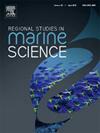Presence, risk assessment, and priority pollutants determination of antifouling paint biocides in Istanbul Beylikduzu Marina, Sea of Marmara, Türkiye
IF 2.1
4区 环境科学与生态学
Q3 ECOLOGY
引用次数: 0
Abstract
Antifouling chemicals are mainly used on water-contact surfaces to prevent biofouling formation on ships or submarine hulls. This study focuses on examining the presence of antifouling paint biocides (Irgarol 1051, chlorothalonil, and dichlofluanid) in the seawater of Beylikduzu Marina, Istanbul, and includes an assessment of their environmental risks. Surface seawater samples were collected from six stations around the marina in the spring, summer, autumn, and winter of 2023. The collected water samples were processed using both liquid-liquid extraction and stir bar sorptive extraction methods, and analyses were carried out using gas chromatography-mass spectrometry. Wilcoxon and Bland-Altman tests confirmed the higher efficiency of stir bar sorptive extraction. The highest concentrations of chlorothalonil, dichlofluanid, and Irgarol 1051 were determined as <MDL, 0.16 µg/L, and 0.24 µg/L, respectively, by liquid-liquid extraction method, while the highest concentrations of these compounds were measured as 0.5 µg/L, 0.81 µg/L, and 1.57 µg/L, respectively, by magnetic stir bar extraction method. One-way analysis of variance (ANOVA) showed no significant seasonal variation in biocide concentrations, while regression analysis suggested a limited influence of water quality parameters, particularly for Irgarol 1051. Hierarchical cluster analysis grouped stations based on biocide concentrations, linking M2-M3 to boat mooring, M5-M4 to restricted circulation, M1 to maintenance, and M6 to external influences, emphasizing the role of anthropogenic and hydrodynamic factors in biocide distribution. The risk assessment indicates that the examined antifouling biocides may pose a threat to aquatic life. Irgarol 1051, in particular, requires attention due to its significant risk quotients.
土耳其伊斯坦布尔贝利克杜祖码头防污涂料杀菌剂的存在、风险评估及优先污染物测定
防污化学品主要用于与水接触的表面,以防止船舶或潜艇船体形成生物污垢。本研究的重点是检查伊斯坦布尔Beylikduzu码头海水中防污涂料杀菌剂(Irgarol 1051、百菌清和二氯氟肼)的存在情况,并对其环境风险进行评估。2023年春、夏、秋、冬季在码头附近6个站点采集表层海水样本。收集的水样采用液液萃取和搅拌棒吸附萃取两种方法进行处理,并采用气相色谱-质谱法进行分析。Wilcoxon和Bland-Altman试验证实了搅拌棒吸附萃取效率较高。液液萃取法测得百菌清、二氯fluanid和Irgarol 1051的最高浓度分别为<;MDL、0.16 µg/L和0.24 µg/L,磁搅拌棒萃取法测得这些化合物的最高浓度分别为0.5 µg/L、0.81 µg/L和1.57 µg/L。单因素方差分析(ANOVA)显示杀菌剂浓度没有显著的季节变化,而回归分析表明水质参数的影响有限,特别是对Irgarol 1051。分层聚类分析根据杀菌剂浓度对站点进行分组,将M2-M3与船舶系泊、M5-M4与限制循环、M1与维护、M6与外部影响联系起来,强调了人为因素和水动力因素在杀菌剂分布中的作用。风险评估表明,所检测的防污杀菌剂可能对水生生物构成威胁。Irgarol 1051尤其需要注意,因为它的风险系数很大。
本文章由计算机程序翻译,如有差异,请以英文原文为准。
求助全文
约1分钟内获得全文
求助全文
来源期刊

Regional Studies in Marine Science
Agricultural and Biological Sciences-Ecology, Evolution, Behavior and Systematics
CiteScore
3.90
自引率
4.80%
发文量
336
审稿时长
69 days
期刊介绍:
REGIONAL STUDIES IN MARINE SCIENCE will publish scientifically sound papers on regional aspects of maritime and marine resources in estuaries, coastal zones, continental shelf, the seas and oceans.
 求助内容:
求助内容: 应助结果提醒方式:
应助结果提醒方式:


